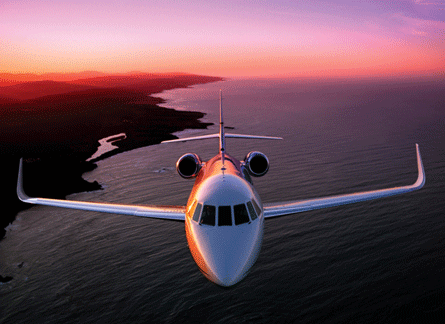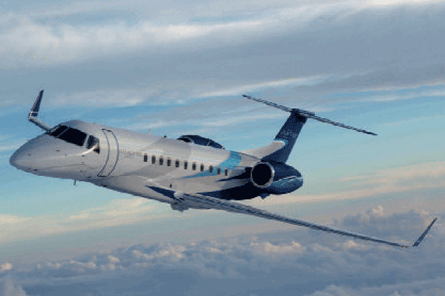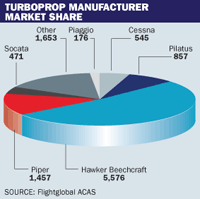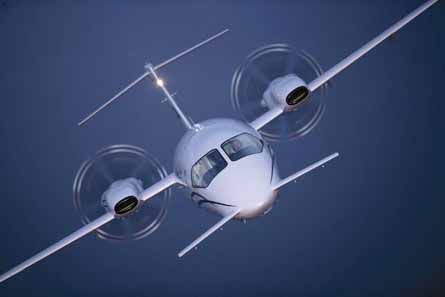It has been an agonising 12 months for business aviation. The financial meltdown across leading international markets triggered last year the worst economic recession for a generation and spawned the most spectacular downturn in business and consumer confidence for decades.
Individual and corporate wealth evaporated and business jets were opportunistically singled out by politicians and the popular press alike as symbols of corporate profligacy and excess - something that should not prevail in the new era of restraint and frugality.
While there will be many potholes and wrong turns ahead, there is now evidence that the global economies are in the early stages of a rebound. How swiftly the effects of recovery are felt among the battered and bruised airframers' remains to be seen, however.
 |
|---|
© Dassault |
According to Richard Aboulafia, vice-president analysis with US consultancy the Teal Group, business aircraft fleets almost quintupled from 1995- 2008, but when the downturn hit, the business aircraft market fell first, faster and deeper than any other aerospace sector.
"The impact of the economic crisis has been far more front-loaded than any other aviation market segment," he says. "This is largely because there is no separation between market demand and the producers. With the jetliner and regional aircraft market segments, it takes some time before end use demand [passenger traffic] filters through the intermediaries [airlines and jet financiers]. When business jet customers suffer, business jet makers feel the pain immediately."
He says the airframers "are doing their best to ride the storm out, but the guys who specialise in products at the bottom half of the market - Cessna and Hawker Beechcraft in particular - have suffered grievously. They have watched their delivery numbers tumble. All they can do is bring costs in line with the new sudden market reality, and hope to regain profitability as they build down inventories and slash workforces."
The economic crisis has forced Teal to revise drastically it latest 10-year forecast. "We are predicting deliveries of 12,768 business aircraft worth $195.7 billion between 2009 and 2018, down from 18,400 business aircraft valued at $270 billion that we predicted last year. This is a transformed industry. But after a serious shock we're headed into a very difficult bust cycle, that will take about three years," says Aboulafia.
While new order intake has taken a hit, the global business aircraft inventory has been cushioned by extensive backlogs built during the heady boom years. Flight International's 2009 business aircraft census - a barometer for the business aviation industry and compiled by Flightglobal's ACAS database - plots the worldwide turbine fleet tally in the 12 months from 31 July 2008. It reveals a modest climb of around 5% to 27,409 jets and turboprops, compared with 26,095 aircraft in last year's census.
 |
|---|
© Embraer |
The worldwide business jet fleet is accountable for the bulk of this growth, climbing from 15,621 to 16,684 aircraft in 12 months.
The turboprops inventory has climbed by 253 units to 10,725 aircraft, reflecting the rising popularity of these cost-efficient aircraft within the business aviation community. The figure includes the removal from this year's census of more than 120 out-of-production types - notably the Mitsubishi MU-2 and Rockwell Commanders - that have either been parked, sold for spares or have been removed from corporate service over the past 12 months.
In this period, however, more than 330 in-production turboprops have been added, boosted by escalating fuel prices and the desire within the business community for more understated modes of corporate transport.
EMBRAER INCREASE
Embraer again recorded the largest percentage increase, albeit from a small installed base, with a 40% rise in its fleet from 142 to 200 business jets. The jump is attributable to the service entry late last year of the eagerly anticipated Phenom 100, of which more than 100 are earmarked for delivery this year. The larger Phenom 300 stablemate is scheduled for certification and service entry this quarter, which will help to boost Embraer's inventory.
The Brazilian airframer also saw a jump in its Legacy 600 tally although production of the super-midsize aircraft is set to fall this year to 14 aircraft. At the top of its range, the large-cabin Lineage 1000 makes its census debut following first delivery of the 190 airliner derivative to Al Fahim of Abu Dhabi in May.
Despite a continued market slump in the segment, Embraer is maintaining schedules for its new mid-range product offerings. The larger Legacy 500 - the fifth business jet in its portfolio is earmarked for service entry in the second half of 2012 a year ahead of its mid-light Legacy 450.
Market leader Cessna has recorded the sharpest climb in its inventory, adding 393 Citation jets to its in-service tally in the census period. With a fleet of 5,633 jets the Citation family - the first member of which made it maiden flight more than four decades ago - represents more than 20% of the worldwide turbine inventory and nearly 40% of the global corporate jet fleet.
CAUTIOUS CESSNA
The hike is attributed to the delivery tallies of Cessna newest models. The superlight XLS+ makes its census debut with a tally of 21 aircraft, the Mustang very light jet fleet more than doubled during the census period from 93 to 200 as Cessna continues to work off the healthy backlogs for the six-seat aircraft.
The combined CJ1+ and CJ2+ light jet fleets climbed by 35% from 172 to 233, the CJ3 light jet total climbed from 233 to 308, the mid-size Sovereign from 206 to 269 and the Encore +, which is being phased out this year, from 24 to 42 aircraft.
 |
|---|
© Cessna |
Scuppered by the recession Cessna has slashed its delivery schedule for this year by around 40% to 275 aircraft - a considerable cut to the 535 Citations it had planned to deliver for before the economic downturn forced its hand. Cessna is not planning to increase numbers until at least 2011 despite the planned service entry in 2010 of its newest light jet the CJ4 - the only Citation under development following the a decision earlier this year to cancel the large-cabin Columbus 850 programme.
Despite a cut in overall production numbers this year Gulfstream has seen its in-service business jet fleet jump by more than 8% from 1,680 to 1817, including a 70% increase in the midsize G150 inventory to 83 aircraft, a 20% increase in the ultra-long-range G550 fleet to 205 aircraft and a 20% boost to its G200 tally to 201 super-midsize jets.
The aircraft is being replaced by the G250, which was rolled out by partner Israel Aerospace Industries at its Tel Aviv base on 6 October. First flight is promised before the end of the year leading to service entry in 2011, preceding Gulfstream's ultra-long-range G650 by a year. The large-cabin business jet - which the General Dynamics-owned company says will be the largest and fastest traditional business jet when it enters service - is scheduled to fly for the first time this quarter.
Bombardier's inventory of in-service business jets has climbed by 188 aircraft during the census period to 3,531. According to ACAS, the large-cabin Challenger 605 saw the largest fleet hike of more than 130% to 82 aircraft, but significant fleet gains were made at the top half of its fleet.
The super-midsize Challenger 300 fleet has increased by 46 aircraft to 243, while the Global 500 and XRS fleet both at 52 last year have climbed to 70 and 88 aircraft, respectively, bringing the Global Express/XRS tally to 200.
Growth at the bottom of the Bombardier line has been stifled by the large inventories of used light and mid-size aircraft. Learjet 40XR numbers jumped from 10 to 27 aircraft, the larger superlight 45XR fleet saw a modest climb from 119 to 152 and the Learjet 60XR rose from 26 to 46. Hopes to boost the inventory of this mid-size model have been dashed following the recent collapse of European fractional start-up Jet Republic that had orders and options for 110 of the types.
Bombardier's out-of-production Learjet fleet saw a modest decline of 35 aircraft that have been parked or sold for parts. In contrast, the increasing popularity of corporate and VIP-configured regional airliners has nudged the fleet of the CRJ200s from 10 to 13 aircraft in the current census.
Dassault has seen a modest 5% hike in its Falcon business jet tally from 1,594 to 1,673 during the census period boosted by a 22-aircraft jump in its 2000EX tally to 162 of the large-cabin types, according to ACAS. The 2000 family has expanded since the last report with the blended winglet-equipped, longer-legged 2000LX - which replaces the EX in service - and de-fuelled 2000DX making their census debuts with four aircraft apiece.
 |
|---|
With a jump in inventory from 11 to 37, the Falcon 7X recorded the largest percentage rise in the census period, from 141 to 162. The larger 900EX/DX fleet has climbed fractionally to 223 and 22 aircraft respectively. The EX will be replaced in service next years by the eagerly anticipated 900LX.
Dassault continues to work behind the scenes on its Future Falcon - a replacement for the out-of-production Falcon 50EX at the bottom of the airframer's range. Although Dassault has chosen the 10,000lb-thrust (45kN) Rolls-Royce RB282-3 to power the aircraft and talked about a 2012 service entry for the super-midsize jet, the aircraft is unlikely to hit the market until 2014 due to the current economic circumstances.
AIRLINER DEMAND
There have been mixed fortunes for the players at the top end of the business jet market. While Airbus and Boeing continue to expand their fleets of VIP-configured airliners. Boeing's BBJ and BBJ2 inventory has remained static during the census period, reflecting the slump in demand for the airframer's archetypal business jet offering.
Even census debutante the 737-900-based BBJ3 records a fleet tally of only three aircraft. In contrast, Boeing has seen its VIP widebody fleet climb considerably, boosting the airframer's corporate fleet tally by 7% to 271 aircraft.
 |
|---|
These former airline-operated aircraft have been courted by an array of markets including heads of state, government/VIP and charter operators lured by the large cabins and low acquisition costs. The numbers of 737s have climbed from 17 to 29, 757s from 17 to 20, 767s from 11 to 14 and 777s from two to four.
The upward delivery trend for the widebodies looks set to continue for Boeing as it prepares to deliver in the next 24 months the first VIP 747-8 and 787-8/9. But the impact of these models on census numbers will be negligible as these top-of-the-range widebodies are in the main being acquired by customers seeking to replace older Boeing types such as the 747.
Airbus has around 30 orders and commitments. Its widebody tally remains static with only the A330 inventory nudging ahead with one addition to the fleet. Nonetheless, the European airframer's business jet family has seen impressive fleet gains, rising by 27 aircraft to 86. The tally is boosted by a hike in A319 Airbus Corporate Jetliner and A318 Elite fleets by 13 and four aircraft respectively.
Hawker Beechcraft boasts one of the broadest product spans and has seen its fleet climb since the last census by 109 aircraft to 2,252, from 2,130. The biggest increases are recorded by the newest members of the midsize Hawker clan, the 750 and 900XP, which saw tallies climb by 80% to 31 aircraft and 75% to 95 aircraft, respectively. This was accompanied by a 16% increase in Premier IA entry-level jet numbers, a 10% increase in the 400XP inventory to 221 aircraft and a similar rise in the 850XP tally to 93.
The overall tally is also boosted - albeit by only 14 aircraft - by the long-awaited service entry of the super-midsize Hawker 4000 late last year following a protracted development programme. The airframer launched last year the Premier II - the latest evolution of the Premier IA light jet. However, it was recently forced to delay the aircraft's expected service entry by more than two years to coincide it said with the predicated rebound in the business aviation market.
TURBOPROP SURGE
The Wichita-based airframer retains its dominance of the turboprop market due to the unrivalled popularity of the King Air. This ubiquitous twin-turboprop represents more than half the world's twin-turboprop fleet at 5,551 aircraft. The in-production fleet has risen by 134 aircraft. This includes 31 350s, 38 B200GTs and 65 C90GT/Is, boosting the fleet to 587, 81 and 184 aircraft, respectively.
The planned service entry later this year and early next year of the uprated 350i and C90GTX should help to broaden the King Air family's appeal, boost fleet numbers and continue to inject life into this 40-year-old model for some time to come.
 |
|---|
© Piaggio |
Piaggio's revamp three years ago of its 20-year-old P180 Avanti has propelled sales of the twin-turboprop to record levels for the Italian airframer. The Avanti II inventory has climbed since the 2008 census by more than 20%, to 78 aircraft, bringing the total Avanti fleet to 176. Demand is particularly strong for the seven-seat aircraft from US fractional operator Avantair, which, with a fleet of Avantis, is seeing strong demand for its programme from former business jet owners.
Piaggio plans to produce about 30 Avantis this year and is trying to expand its business into Australia, Latin America South Africa and South-East Asia to boost sales. Piaggio is continuing to develop its new twinjet, but has no immediate plans to launch the product.
The mass appeal of cost-efficient, understated and versatile aircraft has helped to swell the single-engined turboprop inventory. Across the spectrum the airframers have made significant fleet gains since the previous census.
Heading the single-engined aircraft inventory tally is Pilatus, whose PC-12 fleet has climbed 15% to 857 aircraft, boosted by the popularity of the Next Generation PC-12, which records an inventory of 111 aircraft. The PC-12NG entered service in May 2008 as a revamp of the original PC-12 featuring a Honeywell Primus Apex avionics system and more powerful Pratt & Whitney Canada PT6A-67P engines.
The Stans, Switzerland-based manufacturer plans to deliver around 97 PC-12NGs this year, fewer than the 105 aircraft originally predicted for the 12-month period, due to a handful of cancellations and deferrals.
PIPER PROBLEMS
Piper Aircraft struggle to reignite interest in its low end piston line sales has been offset in part by the continued demand for its Meridian single-turboprop. The high performance turboprop has made a fleet gain of 42 since the last census, bringing the tally to 380.
The Vero Beach, Florida-based airframer is concentrating on bringing to market its single-engined PiperJet in 2011 - one of a new breed of personal jets set to enter service over the next couple of years - which it regards as the company's lifeline.
Cessna's single-engined Caravan has been a redeemer for the airframer during the financial crisis as sales of the utility aircraft have remained consistently strong with around 100 aircraft planned for delivery this year across all markets.
 |
|---|
© Piper Aircraft |
The corporate 208 Caravan tally has climbed from 33 to 35 aircraft since the previous census, although the overall inventory has slipped from 550 to 545 over the same period as older models have exited the listing.
Socata has come under the ownership of French aerospace company Daher since the 2008 census, giving the Tarbes, France-based airframer and aerostructures company potential investment to pursue business aviation programmes that have been on the drawing boards for years while under the stewardship of European aerospace giant EADS.
This includes a twin-engined business jet for which the company is leading an effort to secure funding with a view to launching the new models within the next two years. Meanwhile, its sole offering - the TBM850 - has made fleet gains of 68% since last year's census, bringing the total inventory to 168 aircraft and Daher Socata's global tally to 471.
The airframer does not expect a repeat of these record delivery numbers over the next 12 months admitting that the recession has caused a slowdown in many of its key markets notably Rusia, the UK and the USA.
Quest's single-engined Kodiak inventory has risen more than sixfold to 13 aircraft since the last listing. The tally will continue to rise as the airframer continues to produce three aircraft a month in an attempt to work off its order backlog of at least 18 months.
While single-engined turboprops have flourished over the census period, the very light jet market has deteriorated, taking with it the aspirations of an ambitious new breed of air taxi operators. The past 12 months have witnessed the collapse of pioneering VLJ start-up Eclipse Aviation after delivering only 265 Eclipse 500s and, most recently, Epic Aircraft, maker of the Epic LT turboprop and Epic Jet.
The Russian owners of the A500 piston twin and A700 VLJ quietly dissolved their US subsidiary in April and sold the company's assets to businessman Thomas Heursch, who says he has no plans to resurrect the seven-seat twinjet.
The VLJ market is dominated now by traditional airframers Cessna and Embraer with their Mustang and Phenom 100 jets.
Source: Flight International




















